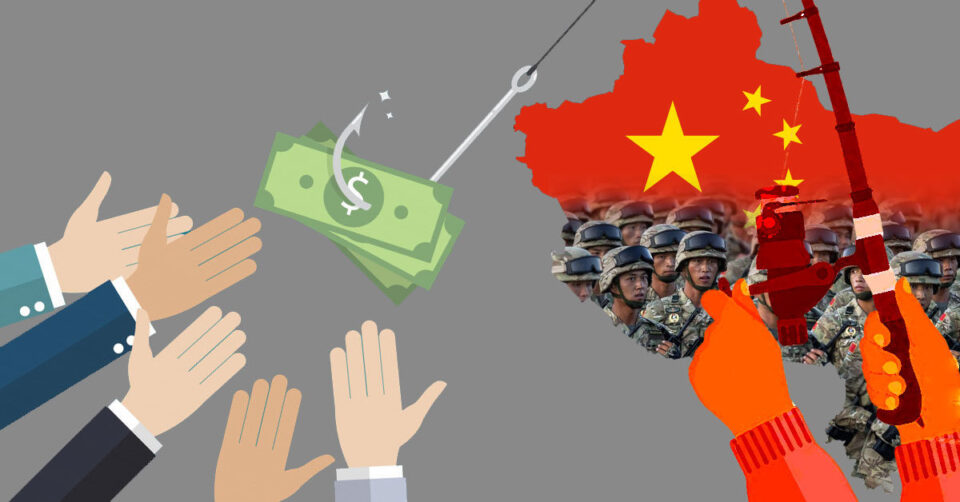The Relation between China and Africa is referred to as Sino – African Relation and this relation dates back as early as the 15 century, However Modern political and economic relations between Africa and China commenced in the era of Mao Zedong, following the victory of the Chinese Communist Party in the Chinese Civil War. Starting in the 21st century, the modern state of the People’s Republic of China has built increasingly strong economic ties with Africa. There are an estimated one million Chinese citizens residing in Africa. Additionally, it has been estimated that 200,000 Africans are working in China.
In 1980, the total China-African trade volume was US$1 billion. In 1999, it was US$6.5 billion and in 2000, US$10 billion. By 2005, the total Sino-African trade had reached US$39.7 billion before it jumped to US$55 billion in 2006, making China the second largest trading partner of Africa after the United States, which had trade worth US$91 billion with African nations.
Many African Countries are currently indebted to china, and china is now exploiting these countries due to the fact that they are unable to repay their loan, What China is doing in Africa is refered to debt trap diplomacy where by China intentionally extends excessive credit to another debtor country with the alleged intention of extracting economic or political concessions from the debtor country when it becomes unable to honor its debt obligations (often asset-based lending, with assets including infrastructure).
There are many African countries that owes china but these are the Top 10 ones with the most Chinese debts.
10. DR Congo – Estimated Debt – $3.4 Billion
The Relationship Between China and the Democratic Republic of Congo dates as far as 1890. Fast forward to post independent DR Congo, China is still one of the biggest Beneficiaries to DR Congo’s Natural resources. Ideally The Democratic Republic of Congo was suppose to be the richest country in Africa since it has the Most Natural Resources more than any other country but due to high debts to China, China is taking away these natural resources as payment of debt. for Example A deal was struck between Sicomines, a consortium of Chinese companies (Sinohydro and China Railway Engineering Corporation), and the Congolese government in April 2008 to grant mineral concessions in Katanga province in exchange for infrastructure investments.
In a deal originally worth US$9 billion and funded by China EXIM Bank, US$6 billion would go to infrastructure development and US$3 billion being invested in mining operations in Katanga. 68% of the project would be owned by Sicomines and the remaining 32% would be owned by Congo’s mining parastatal Gécamines. Critics of the project have alleged that the deal undervalues the mineral deposits in Katanga. The International Monetary Fund (IMF) has raised concerns about this deal negatively affecting the DRC’s ability to sustain its debt. Due to china’s Debt trap, The Democratic Republic of congo has loss most of its Natural resources to china. In 2007, the DRC exported US$304.8 million worth of cobalt to china. In 2008, the DRC exported US$1.13 billion of cobalt to China. Exports of copper ore and hard woods to China also increased greatly and most of these exports are geared towards the payment of loans of construction works done in DR Congo by the Chinese. The country currently owes china about $3.4 Billion dollars.
9.Ghana – Estimated Debts – $3.5 Billion
Relations between the two countries date back to 1960 when the countries first established diplomatic relations. Since then Ghana has provided substantial diplomatic support to the China with the China reciprocating with material support for Ghana’s development. Since the 2000s the volume of Chinese trade and investment in Ghana has increased greatly. From $4.4 million Chinese projects registered by the Ghana Investment Promotion Centre in 2000, Chinese registered flows had increased to $1.6 billion in 2014 alone.
In 2007 China signed six agreements and a US$66 million Chinese loan to expand and upgrade Ghana’s telecommunications network. Beijing provided a concessionary loan of US$30 million to support the first phase of a telecommunications project to link all ten regional capitals and 36 towns in Ghana with fiber optic cables. Recently the China Export and Import Bank (Exim Bank) granted US$562 million loan for the construction of the US$622 million Bui Hydroelectric Dam.
Even though, Ghana has been able to pay China part of its dept through its natural resources but still owes China about $3.4 billion.
8.Nigeria – Estimated Debts – $3.6 Billion
The bilateral relationship between China and The Federation of Nigeria has strengthen through growing bilateral trades and strategic co-oporations. China is considered one of Nigeria’s closes allies and partners.
China is also one of Nigeria’s important trading and export partners. According to a 2015 BBC world service pole 80% of Nigerians view China’s influence positive and only 10% expressing a negative view making Nigeria the most PRo China nation in the world.
In 2006, bilateral trades reached $3 billion up from $384 million in 1998. In 2006 also, China secured 4 oil drilling licenses and agreed to invest $4 billion into oil land infrastructure development.
From 2000 to 2011 there are approximately 40 Chinese official development projects identified in Nigeria through various media reports. These project range from $2.5 million loan for rail, power or telecommunications projects in 2008 for an MOU $1 million construction of houses or wate,r supply in Abuja in 2009 and several rail networks.
Though Nigeria is the giant in terms of Africa’s economy it is drowning in Chinese dept.
7. Cameroon Estimated Debts – $5.5 Billion
China and Cameroon established bilateral relationship on March 26, 1971. Cameroon is adherent to the one China policy. Leading politicians paid visit to and from each country.
Since the first forum on China Africa cooperation in 2000, Beijing has successfully delivered $2.4 billion in development finance
Major projects executed by the Chinese government include a construction of a port, a hydroelectric dam and a malaria research center.
In the 2000s some in Cameroon considered the economic relations to be a form of neo colonialism
6. Zambia Estimated Debts – $6 Billion
In 1998, China nonferrous Corporation (CNNC) bought a controlling 85% stake in Zambia’s copper mine and invested a further$130 million in rehabilitation the mine.
By the end of 2005, about 150 Chinese companies has invested in Zambia.
Trade between the two countries increased in 2010 to $2.2 billion . Chinese investment in Zambia ranges from mining interest in the nation’s copper belt to investment in Agriculture, Manufacturing and tourism.
As of February 2011, a total of 25 farms in Zambia are being runner by Chinese. The country currently owes China about US$6 million dollars.
5.Sudan – Estimated Debts – $6.4 Billion
China is currently one of Sudan’s largest trade partners; importing oil and exporting low cost manufactured items as well as armament into the country. Between the year 2000 and 2008 foreign direct investment made by Chinese firms excluding oil were equivalent to $249 million and bilateral trade between the two countries rose from $103 million in 1990 to $9.7 billion in 2007.
By 2010, China became Sudan’s largest trading partner and these investment had direct impact on the economy prospect of the country as it revenue rose exponentially between 2000 and 2008
More over, it remains largely untouched by the 2008 global economic crisis since its oil exports were managed under long term contract in which the price paid for oil gradually increased irrespective of the world market price. Sudan is currently the fifth African country rolling in Chinese dept.
4.Republic of Congo – Estimated Debt – $7.3 Billion
On February 22, 1964, China established diplomatic relations with the Republic of Congo. Both countries have donated aid projects to each other. The Chinese government fully funded the construction of a €52million new Parliament. The government of the Republic of Congo funded the construction of the China-Congo Primary School; a school mostly for the orphans, after an earthquake destroyed the old school.
Chinese State owned financial institutions have provided development finance for infrastructural development in the Republic of Congo.
Based on media reports, from 2000 to 2012, there were approximately 25 Chinese finance development projects in the country. These projects range from high ways construction to a dam construction. There are several large investment in the Republic of Congo by China.
China Gold is pursuing a copper join venture in the country with the Gerald Group a US based metal trading company. Canadian based Mark industries, owned mainly by a Chinese, owned an advanced stage pottage project that has stalled due to lack of funding.
For a struggling country with such huge debts, one can wonder if such loans would ever be paid.
3.Kenya – Estimated Debt – $7.9 billion
Bilateral relations between Kenya and China dates back to 14th December,1963, two days after the formal establishment of the independence of Kenya after China became the fourth Country to open an embassy in Nairobi.
Bilateral trades between the two countries amounted to $186.37 million in 2002. China exported $180.576 million to Kenya while only importing $5.799 million of Kenyan goods mainly black tea, coffee and leather. Early in 2006,China signed an oil exploration project with Kenya. The latest in the series of deals to expand Chinese over seas business within Africa.
The deal allowed for China state control of shore oil and gas company GNOOC Ltd to prospect for oil in Kenya which is just beginning to drill it’s first exploratory wells on boarders of Sudan and Somalia and I’m coastal waters.
In 2013, President Kenyatta visited China; he held talks with his Chinese counterpart Xi Jinping, both countries ended up signing deals worth $5 billion.
Kenya currently owes China an estimated $7.9 billion.
2.Eithopia – Estimated Debt- $13.5 billion
The economic relations between both nation can be best described as multi faceted. By 2000 and 2014 China provided over $12 billion in loan finance usually tied to an infrastructural development undertaken by a Chinese firm. There is growing Chinese investment in the Ethiopian economy while imports of cheap consumer goods from China worth US$3.4 billion in 2015 greatly exceeding exports from Ethiopia to China US$380 million in 2015.
The Chinese appear to be interested in Ethiopia for political reasons. Among African countries its governance and political orientation is closest to that of China and it host the African Union headquarters. And as a business partner, Ethiopia focus on infrastructure has created numerous opportunities for Chinese firms.
Chinese aid to Ethiopia include the dispatch of a medical teams and teachers and educational scholarship for Ethiopian students studying in China.
1. Angola – Estimated Debt- $25 billion
Currently the first African country with the most Chinese debt is Angola. Whether try will even be able to repay this loan is a mystery.
The relations between both nations began in 1983. As of 2007, Angola was Chinese biggest trading partner in Africa. Trade between the two countries is worth over $24 in 2010.In 2011 and the early parts of 2012, Angola was the largest trading partner with China followed by South Africa.
In 2016, trade between the two countries was worth $15.6 billion. Chinese sports to Angola amounted to $1.68 billion and Angolan export to China amounted to $13.9 billion.
Since the first forum on China African cooperation conference, Beijing has completed $465 million of official development projects in Angola.
Financial amounts normalized in 2009, this includes a $90 million loan from the EXIM bank of China for the rehabilitation of the Rwandan railway and the construction of the 45km distribution of electricity line in the country.
Angola has also received $1 billion oil back line of credit for China EXIM bank to repairs the countries infrastructure.
These are the top ten African countries with the most Chinese debt.


